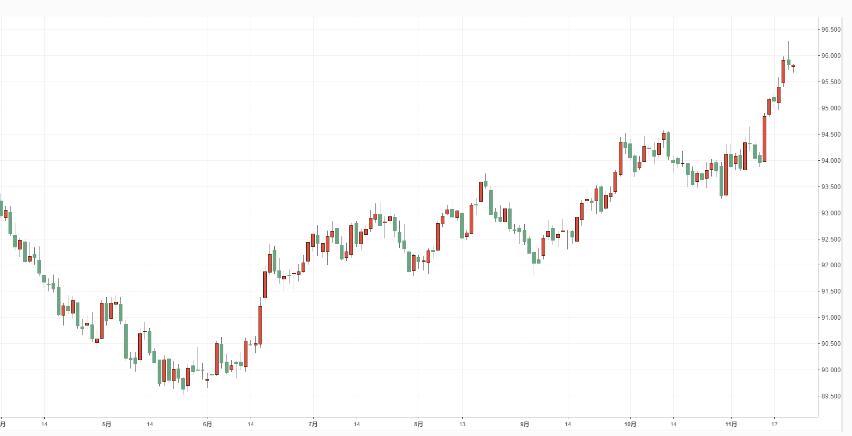Red flags in the dollar

On Wednesday, the U.S. dollar index rose and fell, eventually falling 0.12% to 95.797, ending the recent continuous explosive rise.
Reasons for the rise
The increase in interest rate expectations is the fundamental reason for the jump in the dollar index this round.
According to the latest data, the United States recorded an unadjusted annual rate of CPI of 6.2% in October, exceeding all economists' expectations and hitting a new high in more than 30 years; the unadjusted core CPI in October recorded an annual rate of 4.6%, a new high in 30 years.
The soaring inflation has increased the pressure of the Federal Reserve to raise interest rates in advance, supporting the U.S. dollar index.
But the fact that prices and currencies rise at the same time is inherently contradictory.
Prices and currencies rise at the same time
The simple truth is that rising prices mean currency depreciation.
The Fed’s excessively loose monetary policy and seemingly endless purchases of bonds to create new U.S. dollars will ultimately increase inflation and weaken the U.S. dollar’s position as the core of the global financial system.
All things being equal, rising consumer prices should be detrimental to money, because it means fewer goods and services that people can buy with money. In the past, allowing prices to rise sharply and the resulting hyperinflation has made the currencies of some countries practically worthless.
However, as the U.S. inflation rate continues to rise and hit new highs this year, the U.S. dollar is also appreciating. So far this year, the U.S. dollar index has risen by about 6.5%, and it has soared to a new high for the year, while the US CPI has risen sharply from 1.2% to 6.2% during the same period.
If the recent increase can be understood as the result of the Fed's interest rate hike expectations, why has the previous continuous increase in inflation not led to a depreciation of the dollar?
Economic recovery is at the core
Changes in exchange rates are relative and only meaningful in comparison with other central banks and currencies.
The UK’s CPI this year has soared from 0.3% to the current 4.2%. Although the absolute value is not as large as 6.2% in the United States, the increase is more than 2.5 times that of the United States. At the same time, although the Bank of England unexpectedly did not raise interest rates at the last interest rate meeting, the Bank of England has always declared that it is about to start raising interest rates, which is much more radical than the Fed's statement of "being patient with interest rate hikes."
According to the logic of the dollar’s rise, the pound should have a greater rise, but the pound/dollar has been in a volatile downward trend for most of this year.
Therefore, the impact of inflation and interest rate hike expectations on the exchange rate may be short-lived, and the main factor driving the exchange rate is the development of the domestic economy.
Prior to this, the US economic data was generally better than expected, while the Eurozone and the UK were mixed. Especially in the Eurozone, the gap between the US and European economic indexes compiled by Citigroup has reached its highest level since October last year. Therefore, the rise in the dollar is mainly due to the better economic situation than its opponents. In addition, the recent US retail data has performed well, and the US GDP growth rate in the fourth quarter may accelerate, which supports the future trend of the US dollar.
Red flag
Judging from the daily chart, the U.S. dollar index has risen and fallen after a round of upswing, appearing a hanging line pattern. This pattern has appeared at relatively high points many times before, and there is a high probability that it will usher in an adjustment afterwards. However, the trend of dollar bulls has not changed, and a correction may usher in better buying opportunities.



